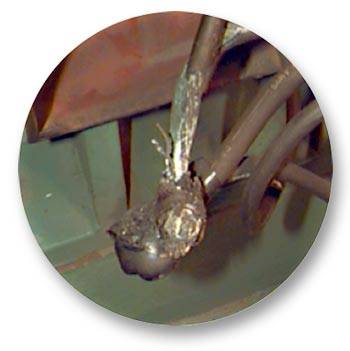Making Reliable Motor Connections
Motor connections that keep you running – Low Voltage Applications
Motor connections that keep you running – Low Voltage Applications

A proper motor connection is a fundamental and often overlooked component to a reliable motor circuit. Unfortunately, our test teams and repair shops continue to find problems with high resistance and grounded connections resulting from:
- Vibration
- Heat
- Moisture
- Contaminants
- Improper handing
- Compression in Jbox (too small)
The two areas to consider for improvement are the connection itself and the insulation. The connections should fit within the junction box with some allotment of movement and must have a mechanical connection strong enough to maintain integrity during temperature changes and exposure to continued vibration.
Things to consider and avoid when connecting motor leads:
- Connections will require “disconnecting” in the future! Make a connection that can be opened without creating unnecessary work.
- Avoid wire nuts and crimp connections (low voltage and single phase applications) as they constantly fail prematurely.
- While uncertain of the prevailing cause, we often find high resistance connections with “gel cap” devices, so you may consider avoiding those.
- Most junction boxes were not designed to accommodate three (or more) sets of fully wrapped split bolts.
Some suggestions for a great motor connection
Our winding teams specify soldered lugs for all in house work. That is not always as practical in the field, so:
- Use a bolted, compression lug as a standard, such as a T&B Color-Keyed.
- Apply a joint compound, such as T&B Kopr-Shield or Aluma-Shield to reduce resistance and prevent corrosion.
- Use compression lugs properly sized for your motor lead cable type. This is one topic worthy of additional coverage, so we will likely have another post on it.
- Bolt your lugs together with quality made fasteners including a split washer (and flat washer) or even better a Belleville washer (and flat washer).

Be sure to match the lug to the cable and size. Most lug manufacturers offer several application tools to support lugs, such as the color T&B keyed wall chart.
For a convenient, quick disconnecting, low voltage motor connection consider the T&B Motor Lead Disconnect. They take a bit more space, but in the right environment can offer a much faster working connection. Some of the benefits include:
- Compression connectors
- Snap together disconnects requiring no bolting
- Formed insulating boot requiring no taping
For more details on using this disconnect, take a look at T&B’s video comparison below:









